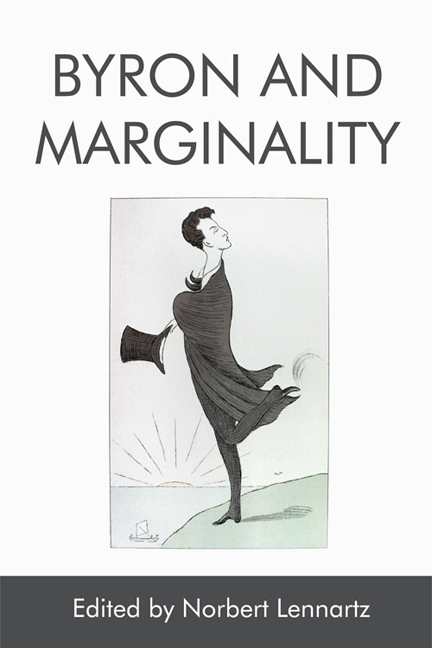Book contents
- Frontmatter
- Contents
- Foreword
- Acknowledgements
- Editions and Abbreviations
- 1 Lord Byron, Wandering and Wavering between the Centres and Margins of Romanticism: An Attempt at an Introduction
- I Byron’s Marginalisation in Romantic World Literature
- II Byron’s Marginal Identities and Places
- III Cherishing the Marginal – Marginal Genres in Byron
- IV On the Provocative Margins of Taste
- V Marginal Affairs – Visual and Paratextual Aspects in Byron
- List of Contributors
- Index
5 - ‘When a man talks of system, his case is hopeless’: Byron at the Margins of Romantic Counterculture
Published online by Cambridge University Press: 06 May 2021
- Frontmatter
- Contents
- Foreword
- Acknowledgements
- Editions and Abbreviations
- 1 Lord Byron, Wandering and Wavering between the Centres and Margins of Romanticism: An Attempt at an Introduction
- I Byron’s Marginalisation in Romantic World Literature
- II Byron’s Marginal Identities and Places
- III Cherishing the Marginal – Marginal Genres in Byron
- IV On the Provocative Margins of Taste
- V Marginal Affairs – Visual and Paratextual Aspects in Byron
- List of Contributors
- Index
Summary
The structure of Romanticism
When we talk about Byron and the margins of Romanticism, this is a question of positioning Byron and, thus, first of all of defining the construct of Romanticism(s) to which we are referring. In this chapter, I will selectively focus on a conceptualisation of Romanticism as a countercultural movement in order to examine Byron's marginal status as a countercultural agent via his involvement with Leigh Hunt and The Liberal.
This volume's title hints at a critical re-examination of the Wellekian view of Byron as, in Jerome McGann's words, ‘the debased margin of a complex cultural center’, a position that, for a long time, rendered Byron's position within studies of Romanticism problematic. The necessary theoretical groundwork for a reinterpretation is found in some recent proposals, such as Michael Ferber's or Christoph Bode’s, to define (European) Romanticism through a set of Wittgensteinian family resemblances: by relying on a network of entities that are interrelated through a number of partially shared characteristics rather than, as Classical theory has it, a limited number of necessary and sufficient conditions for a poet or work being styled as Romantic, these approaches allow for a framework that is sufficiently complex and open-ended not only to affirm Byron's position within Romanticism but also to map it out in detail. Where the Wittgensteinian model, however, is undecided concerning the internal structure within a category – each member is defined exclusively by its interrelations with other members rather than being mapped on to a general structure characteristic of the overall category – this is clearly not how most scholars perceive the structure of ‘Romanticism’: while the idea of strict hierarchies and canons is debatable, we do want to be able to say that, for instance, William Wordsworth may be more representative of Romanticism than John Hamilton Reynolds, or, to take two examples from Ferber's list of distinctive traits of Romanticism, that ‘imagination for the view of poetry’ may be more central than the characteristic ‘volcano as a theme’.
This possibility is provided by prototype theory, an important development building on Wittgenstein, which was pioneered by the experimental psychologist Eleanor Rosch and significantly extended as a general theory of categorisation by the cognitive linguist George Lakoff.
- Type
- Chapter
- Information
- Byron and Marginality , pp. 77 - 97Publisher: Edinburgh University PressPrint publication year: 2018



